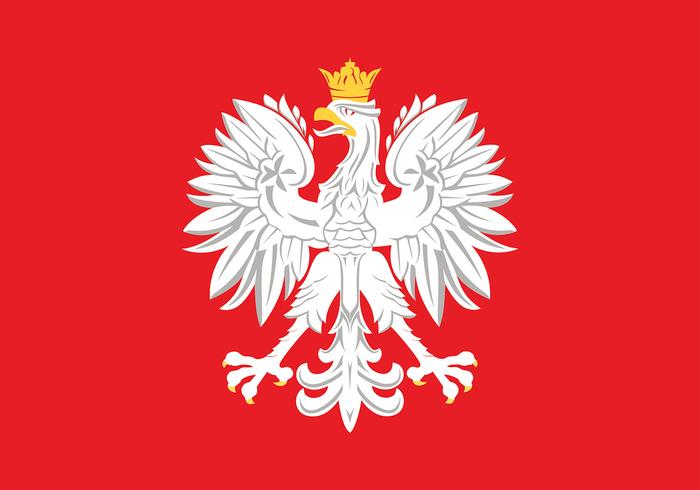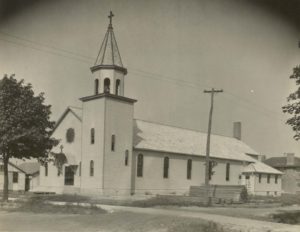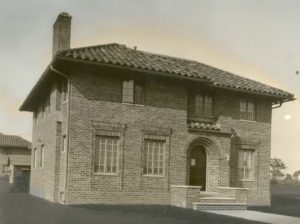St. Hyacinth
Toledo Polish Churches > St HyacinthSt. Hyacinth Parish: The Jewel of the Boulevard As the number of Polish-American parishioners at Saint Stanislaus Church increased, Bishop Samuel Stritch directed Father John Lubiatowski to found Saint Hyacinth Church on July 7, 1927. The last national parish established in the Diocese of Toledo for Polish-Americans, Saint Hyacinth’s geographic area was west of the railroad tracks near Brown Avenue. Father John, as he was commonly known, celebrated Mass at St. Stanislaus Church at 10 a.m. on Sundays for about 100 families. The diocese purchased property between Evesham and Parkside Boulevard in August 1927. Valuing the education of their children, parishioners donated $700 to buy a portable classroom building from Saint Ignatius Church in Oregon, Ohio. Four Franciscan Sisters from Sylvania, Ohio opened the four classrooms of St. Hyacinth School on September 17, 1927, under the leadership of Principal Sister Mary Imelda Czubek, OSF. On December 7, 1927, Leo Herman of Bowling Green, Ohio signed the contract to build the new church for a cost of $16,000. The Gothic-style, wooden structure was 110 feet long by 42 feet wide with seating for 400 people. The cornerstone and bell were blessed on Sunday, December 18, 1927. The contractor, his crew and men from the parish together with Father John worked day and night to be ready for the first Christmas Day Mass on a portable altar. Dr. and Mrs. Francis Pilliod donated a magnificent Gothic wooden altar to the Ursuline Sisters for their chapel on Cherry Street. The Sisters, in turn, gave the altar to the new parish providing for its return once St. Hyacinth Parish could afford its own altar. The Holy Name Society donated the statue of Saint Hyacinth. Over the years, new statues filled the niches in this altar. Architect Aloysius Herman designed and contractor Leo Herman built a brick rectory and convent on Evesham in early 1928. More property was purchased in June in order to erect a permanent eight-classroom brick school, costing $25,955. No more buildings or improvements were made during the years of the Great Depression and World War II. In 1953, the rectory was enlarged, and the parking lot was paved. On December 6, 1954, Father John died suddenly; he had served the Polish-American people of St. Hyacinth for 27 years. On a rainy day, the school children and the sisters lined the sidewalks around the property while reciting the rosary in his honor. Father Wenceslaus A. Czajkowski came from Saint Mary Magdalen Church in Rossford, Ohio to be the second pastor in March 1955. “Father Czaj” (pronouced “Chi” like a long “i”) had to solve three problems: overcrowding in the school, remodeling of the convent and increasing the size of the church for 3,155 members. The new pastor and parishioners worked together to add three classrooms and a wing to the convent with a chapel and more bedrooms. A new church with seating for 700 people was the solution to overcrowding. Two hundred sixty-six families contributed $2.00 each Sunday until they reached $300; eighteen families surpassed the goal. On March 8, 1959, the last Sunday Masses were celebrated in the Gothic wooden church; the old church was demolished during Holy Week. Mass was celebrated in the school basement during construction. On September 30, 1959, Bishop George J. Rehring blessed the new cornerstone; on March 24, 1960, services were held in the new church. Architect Harold Munger designed a contemporary church with some 6th century basilica elements. Comte Construction erected a magnificent church with Italian marble wainscoting, bays with dormer- style windows along the sides, a mission tile roof and a bell tower. Special features of the new Saint Hyacinth Church include: a fifteen-foot stained glass window of St. Hyacinth, stained glass windows of the Seven Sacraments, and a life-size marble crucifix. The total cost was over $325,000. Bishop Rehring presided over a solemn blessing and Mass on Sunday, May 29, 1960. Through the next four decades, seven pastors served this Polish-American community. Remodeling and renewal of the church and school continued. Joseph Jakutowicz organized the first Polish-American festival of music, food and games in 1970. Through the work of many people from all the Polish parishes, the festival grew and moved to the Lucas County Recreation Center; it evolved into the Lagrange Street Polish Festival. The parishioners, through the councilmen, ushers, Parish Council, Pastoral Council, Altar Rosary Society, Holy Name Society, Saint Francis Guild, Saint Vincent de Paul Society, Parents and Teachers Club, Sodality of the Blessed Virgin Mary, Boy Scout Troop No. 161, Cub Scouts, St. Hyacinth Seniors Club, Men’s Choir, and Ladies Choir, supported each other and their church. Although changing demographics caused school enrollment and parish membership to decline, the people of St. Hyacinth are dedicated to their Catholic faith and Polish-American traditions. St. Hyacinth School was closed in 2005; a charter school paid rent for the building. St. Hyacinth Parish was twinned with St. Charles Parish in 2005. Pastors of St. Hyacinth Parish: Reverend John F. Lubiatowski (1927-1954) Reverend Wenceslaus Czajkowski (1955-1972) Reverend P. J. Kokocinski, adminstrator pro tem (1972) Reverend Bede Slominski (1972-1983) Reverend Paul Camp (1983-1989) Reverend John C. Shiffler (1989-1995) Reverend Jonathan C. Wight, administrator (1996-2003) Reverend James R. Sanford (2003-2004) Reverend Nelson G. Beaver (2004-2005) Reverend Gregory L. Peatee (2005-present) Principals of St. Hyacinth School: Sr. M. Imelda Czubek (1927- Sr. Lynda Snyder, SND (1997-2005?) First Baptism: Rita Dolores Puczynski, daughter of Casimir Puczynski and Frances Arent, born on Sept. 19, 1927. Baptized on Sept. 25, 1927; godparents Wenceslaus Zaborowski and Lola Arent First Marriage: Walter Biernacki and Anna Koperska, witnesses Stephen Biernacki and Cecelia Koperska Married on Nov. 7, 1927 First Funeral Mass: James Czaplinski, Nov. 2, 1927 First Communion Class: June 1928 First Confirmation Class: May 30, 1932, administered by Most Reverend Samuel Alphonse Stritch, Bishop of Toledo First Councilmen: Anthony Iwinski, Andrew Nowaczyk, Frank Robaszkiewicz, Sr., Stanley Siwa, Thomas Wilczynski Altar Boys for the First Christmas Mass, 1927: Chester Balcerzak, Albin Glesmer, Clem Ignasiak, Richard Koski, Walter Operacz, Stan Krzyminski, Ollie Plenzler, Dan Przybylski, Ollie Przybylski, Walter Siwa Patron Saint: St. Hyacinth, Hiacynt (in Polish) or Jacek (nickname in Polish) of Konski, feast day August 17 St. Hyacinth was born Jacek, the son of Eustachius Count of Konski, of the noble Odrowaz clan/family (in Polish heraldry a clan of unrelated families bore the same coat-of-arms). He was born about the year 1185 at Lanka Castle in Kamien Slaski, (Kamin, Silesia) Poland. As a young man, he studied at Krakow, Prague and Bologna, where he earned a doctorate in law and divinity. He ministered in Sandomir, Poland. Father Hyacinth traveled with his uncle Ivo Konski, Bishop of Krakow, to Rome. He and Blessed Ceslaus (Czeslaw in Polish), his brother or cousin, received the habit of the Order of Preachers (OP) from its founder Saint Dominic at the Basilica of Santa Sabina iin 1218 to 1220. They were the first members of the Dominican Order from Poland. They proclaimed the word of God and founded convents in Austria and Poland. A dedicated missionary, Hyacinth preached to the peoples of Prussia, Pomerania and Lithuania. According to tradition, he crossed the Baltic Sea to convert the inhabitants of Denmark, Sweden and Norway, and he journeyed to Lower Russia, even to the shores of the Black Sea. Because of this, he was given the title of Apostle of the North. He spent the last few months of his life in Krakow, where he died on August 15, 1257, shortly after attending Mass. He is buried at the Church of the Dominican Fathers in Krakow. Pope Clement VIII canonized him in 1594. The feast of Saint Hyacinth, the Apostle of the North, is now celebrated on August 17. St. Hyacinth is the patron saint of people in danger of drowning. His first of many miracles associated with water, was when he said a prayer and made the sign of the cross, and then walked across the flooded Wisla (Vistula) river, followed by his missionaries and a crowd of people. St. Hyacinth is pictured with a monstrance and a statue of Mary due to a Mongol attack on a monastery in Kiev. As he clutched a monstrance or ciborium containing the Blessed Sacrament, Hyacinth heard the voice of the Blessed Virgin Mary begging him to take her. Miraculously, the statue became weightless, and he carried both to safety. There is an old Polish expression of surprise, “Swiety Jacek z pierogami!” This means “Saint Hyacinth and his pierogi!” The saying is similar to the American “good grief.” Hyacinth fed the the poor people of Krakow with pierogi. Legend has it that pierogi was a dish invented by Hyacinth. Prayer: Sr. Hyacinth, Patron of our Parish, you are a great symbol of our Polish Heritage. Under your guidance and protection, let all your ideals be of deep spiritual value. May you devotion and love for our Lord in the Eucharist and the Blessed Virgin Mary be the foundation of our spiritual life. We ask this through Christ our Lord. Amen. Address: 719 Evesham Avenue (Parkside Boulevard at Victory Avenue) Toledo Ohio 43607 Bibliography: “Saint Hyacinth,” Hanley, John and Scalia, Rosalia, A History of the Diocese of Toledo. Strasbourg, France: Editions du Signe, 2009; page 215. “Saint Hyacinth Catholic Church, 80th Anniversary Mass of Thanksgiving, ” August 17th, 2007 ~ 5:00 p.m. “Saint Hyacinth Catholic Church; Toledo, Ohio; Celebrating 80 Years,” 2007. “Saint Hyacinth,” Catholic Encyclopedia online, retrieved 16 April 2012. “Saint Hyacinth,” Wikipedia, retrieved 16 April 2012. “The Lineage of Saint Hyacinth of Konski” compiled by Margaret Odrowaz-Sypniewska, angelfire.com website, retrieved May 2012. Clerus Toletanus: A Directory of Clergy, Religious Communities and Parishes of the Diocese of Toledo in America, 1910 to 2011, vol. 1 no. 1
|


